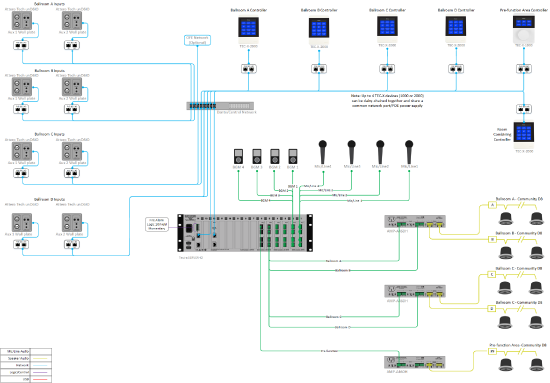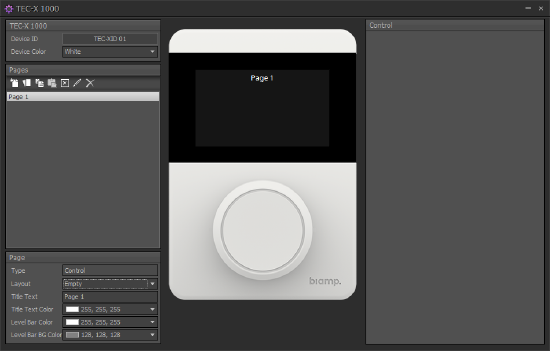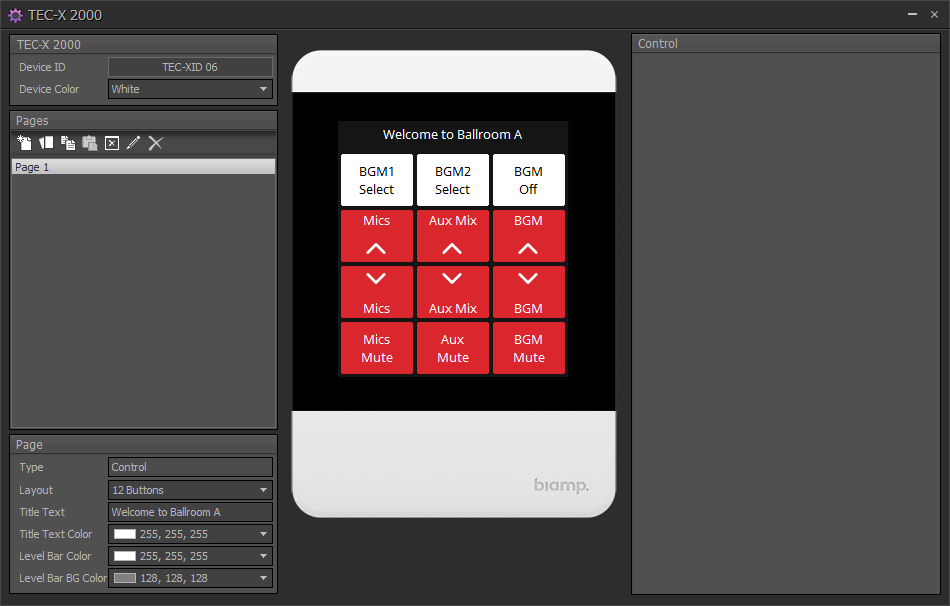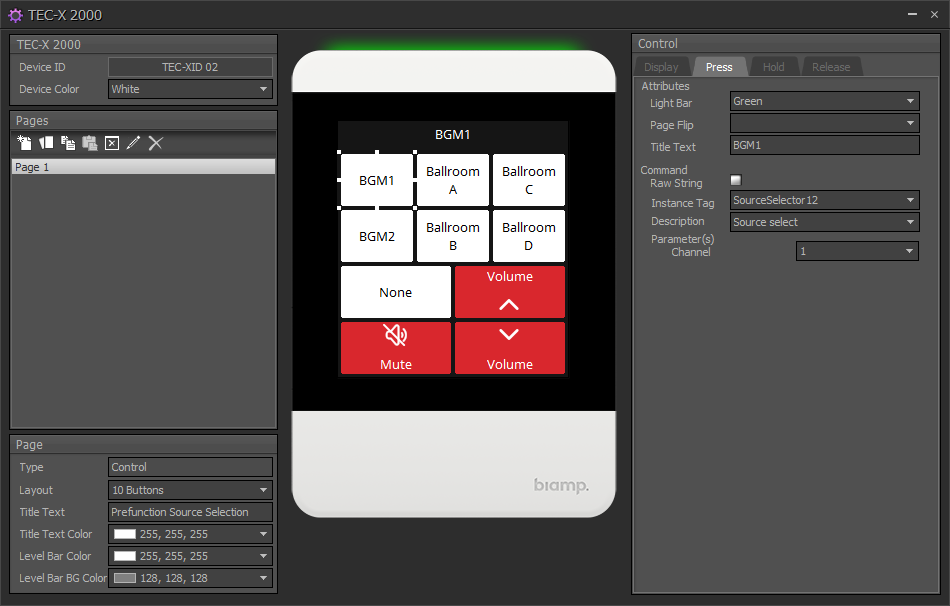4-way Divisible Hotel Ballroom with TEC-X control
This system design template shows how Tesira products can be used in a small divisible hotel ballroom room installation. A typical ballroom can be setup to accommodate distributed audio throughout the spaces from a number of auxiliary room input locations along with selectable background music sources.
In this hotel ballroom example, we will be setting up a flexible audio system utilizing the Server I/O hardware with wall-mounted TEC-X-2000 user control interfaces located in each ballroom along with the pre-function area. Each ballroom will consist of two Dante wall plate locations, each with microphone and stereo line level inputs. These sources will be controlled with individual level controls, and mixed to the distributed speaker outputs as required for the specific design. There will be two background music sources available to the ballroom systems with source selection and level control. There will be four analog mic/line inputs available at the rack location to allow for wireless microphones or other auxiliary sources to be fed to each room. An additional TEC-X-2000 is included to manage room combining preset recalls. This single panel could be upgraded to one in each room if desired.
The application will also include a pre-function area audio feed to distributed ceiling speakers with the ability to select background music sources, or any of the ballroom audio for overflow purposes with a TEC-X-1000 wall mounted controller. Each ballroom control panel will have the ability to mute the feed to the overflow if desired. Return audio to the Dante wall plates will be available to route for extra room outputs or recording purposes. Finally, a logic circuit will allow all zones of audio to be muted by a contact closure trigger from the fire alarm panel.
NOTE: The TEC-X details in this article apply to Tesira software version 4.4.0 or newer and Tesira Firmware Version 4.4.0 or newer. Both can be downloaded from here (the link opens in a new tab).
Room design
- Two Dante wall plate input locations in each room supporting both Mic, Line, or Aux level signals to room distributed speaker system. These locations will also have the ability to have audio routed back to the 3.5mm connection from the matrix mixer in the file for line level output.
- Four analog Mic/Line inputs at rack location for additional auxiliary source inputs to system.
- Two selectable analog background music inputs to each ballroom system. Expansion capability to add two additional sources.
- 70V distributed ceiling speaker feed to support speech reinforcement and/or BGM sources.
- Pre-function area 70V distributed ceiling speaker system with source selection of background music sources or ballroom audio. Ability to mute the ballroom feed to overflow from each ballroom's control interface.
- System level, source select, and background music control via wall mounted TEC-X-2000 wall panels.
- Room combining preset recall via wall mounted TEC-X-2000 wall panel.
- Pre-function area 70V distributed ceiling speaker system, with source selection of background music sources or ballroom audio via wall mounted TEC-X-2000 wall panel.
- User interface for advanced control and routing via Canvas software.
- System logic inputs to trigger system mute to all areas from third-party fire/emergency contact closure.
- Optional logic inputs on Server I/O for room partition sensor connectivity.
- 8 Spare Input Channels for future room expansion.
Equipment list
Below is the list of Biamp equipment used in this project:
- 1 - Server I/O SIC-4 (4), SOC-4 (2), DAN-1 (1): 16 mic/line level inputs; 8 mic/line level outputs, 64 x 64 channels of Dante networking
- 8 - Attero Tech unD6IO-B Dante Networked Audio Wall Plate - 4x2 Multi I/O; 2 XLR, 2 x RCA, 3.5mm stereo input and outputs.
- 6 - Tesira TEC-X-2000 Tesira PoE Network AV Control Pad; up to 12 buttons (4 for Room Level Control / 1 for Room Combining/ 1 for Pre-Function)
- 13 - PH POE36U-1AT-R Gigabit PoE+ Injector, IEEE802.3af compliant, IEEE802.3at, PoE capable network switch, or equivalent PoE injector
- 3 - AMP-460H 4-Channel, 60W class D amplifier; supports both 70V and 100V constant-voltage speaker systems
- Community D8 Two-way, high output full-range, coaxial ceiling loudspeaker, 8 ohm or 70V/100V operation, 150W continuous (Quantity as required)
Note that other non-Biamp equipment is required, including the microphones, background music sources, stereo program source device, network switch, and fire alarm panel interface.
Example file
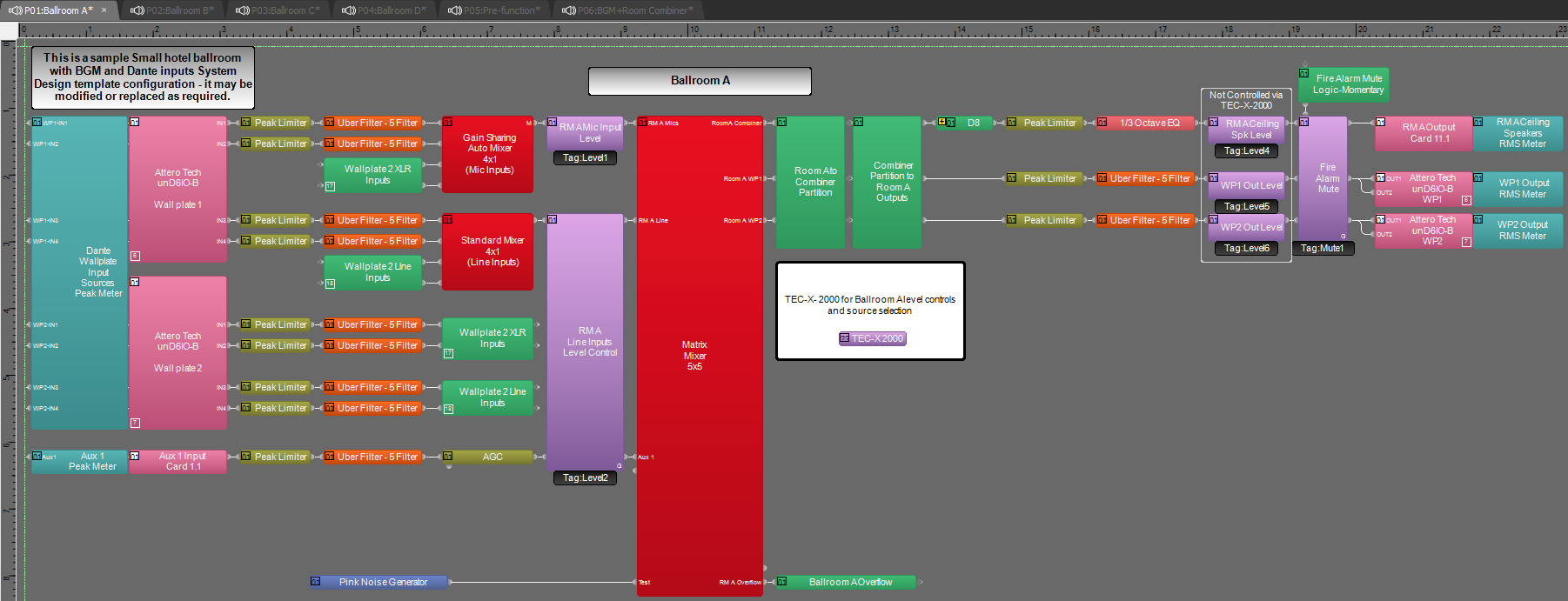 The example file for this system design template is set up with all the required I/O, processing, and control blocks required for the functionality scope and is ready to load to the system. In the file, the matrix routing is setup for microphone/line inputs, aux inputs and background music to be fed to the distributed speaker system. These routes may be changed or modified as needed to fit specific the design application. Dante Controller matrix routing must be done after sending the file in order for audio to pass between the devices.
The example file for this system design template is set up with all the required I/O, processing, and control blocks required for the functionality scope and is ready to load to the system. In the file, the matrix routing is setup for microphone/line inputs, aux inputs and background music to be fed to the distributed speaker system. These routes may be changed or modified as needed to fit specific the design application. Dante Controller matrix routing must be done after sending the file in order for audio to pass between the devices.
The file contains partitions for each ballroom space and the pre-function area along with a room combining partition. This will allow for the system updates to the ballroom and pre-function partitions to be done without stopping audio in other active spaces.
Presets have been included to recall combining states for A+B, C+D, all Rooms Combined, and All Rooms Separated. There is also an optional wall logic input that will allow for physical partition sensors to be wired to the Server I/O's logic inputs to trigger presets based on wall states. A single TEC-X-2000 has been included in the design to recall room combining presets. If desired, additional TEC-X-2000 controllers can be added to each room allow for Combining functions to be available in each room along with provided audio level control. In this design, TEC-X controllers are shown in a home run topology, but can also be daisy chained in groups of up to 4 devices on a single PoE power supply.
To assist with deployment and commissioning of systems which include the Community D8 speakers, a Tesira Library File (.tlf) has been created. This includes custom blocks with Biamp's recommended EQ curves to optimize the sound the included loudspeakers in this design. The custom blocks have been included in this system design template file. These blocks can also be found in the Processing Library in Tesira software.
The file's Equipment Table is populated with proper hardware to match the layout, but will need to have serial numbers and proxy host assignments added before loading the file to system. The file download includes an optional Canvas control file that can be used for advanced routing and control of the system if required.
Note: Tesira software and firmware version 3.4 and higher is required for Attero tech Dante wall plate support.
The .zip file below contains the example Tesira and Canvas configuration files for this hotel ballroom application.
File Download: 4-way Divisible Hotel Ballroom, TEC-X control
Networking details
The sample small divisible ballroom application will make use of both the Control and Dante network interfaces of the hardware to achieve a fully functioning room environment. This system is small enough to be placed on a very small local AV switch, but is also equally capable of being integrated into a larger building network sharing larger switches for control traffic. For a more detailed guide on how to implement in a larger range of network applications, it would be helpful to reference our Tesira Network Infrastructure article.
Hardware devices will need to be discovered in Tesira software before the configuration can be sent. The PC must have a unique IP address in the same subnet as the TesiraFORTÉ device. A TesiraFORTÉ device is configured from the factory with DHCP or Zero Conf (Link Local) address. If you wish to verify your PC network interface is set correctly, please review the Setting an IP address section. More details of system connections can be found here.
In the system diagram, the Control and Dante networks are shown sharing a common switch due to smaller system size. This topology can be used if desired, or changed to use a stand alone switch for the Dante network. The Dante interface on the Tesira Server I/O will be configured from the factory with DHCP enabled. To make any changes to this Dante interface, any running system configuration must be cleared from the hardware. Attero Tech wall plates must be on same subnet as the Dante interface of the Tesira Server I/O's DAN-1 card.
The Dante audio network’s signal routing must be done via Dante Controller software on either a Mac or PC. It can be downloaded from http://www.audinate.com. Channel names are advertised to Dante Controller once the Tesira configuration file has been sent to the Tesira hardware. Channel names for Tesira hardware must always be changed in Tesira software, and should never be changed in Dante Controller. Further reference on Dante network configuration and requirements can be found here.
Setup Requirements:
- Control/Dante network switch with sufficient ports and PoE capable port(s)
- Attero Tech wall plates are on the same subnet as the DAN-1 Card on the Server I/O.
- 802.3at (Class 2) PoE injector(s) for powering the TEC-X controllers or PoE capable port. TEC-X requires 7W.
- 802.3af (Class 1) PoE injector or PoE capable port for powering each Attero tech unD6IO-B.
- Connection to Owner PC and network for Canvas user interface control.
- TEC-X devices need to be connected to the same network and discoverable by Tesira Software.
- Up to four TEC-X devices can be daisy chained together.
Audio setup
- Follow Gain Structure best practices to set input and output levels of microphones and sources. Input and output gain levels have been left at default settings for integration flexibility of the file. Input and Output metering has been added to assist with setting gain structure within the file. Additional meters can be added to the file as required to allow for additional detail at point along the signal path.
- Attero Tech wall plates will appear as both Dante transmitters and receivers in Dante Controller. These must be connected in the Dante Controller matrix to the matching Dante input and output channels of the Tesira system in order for audio to pass between the devices. Default channel names for Dante blocks are in place, but may be changed as needed before sending the file to system.
- Dante wall plate inputs 1 and 2 have been set to "Mic Gain-High" on all blocks with phantom power in the off setting. This will provide proper mic gain for dynamic microphones, but may be changed per input as needed to fit the room design needs.
- Dante wall plate inputs 3 and 4 have been set to mix the signal from the RCA and 3.5mm inputs. This may be changed as needed to fit the room design needs.
- Upper and lower limits have been added to level blocks for user facing controls. These can be adjusted to fit the design application as needed.
- Select constant voltage(CV) and bridging on amplifier channels to support room speaker topology. Refer to room design signal flow diagram for more details.
- Uber Filters and Limiters have been added to all signal paths to allow for any additional equalization and signal management as needed to sources. Additional filtering or dynamics blocks may be added or changed as needed to achieve the desired results in the file.
- A graphic eq DSP block has been added to all speaker outputs to allow for room tuning and equalization. For a more detailed guide on room optimization, we have provided a room equalization article that can be referenced here.
- Logic for fire alarm muting is setup to mute all audio paths for the duration the contact closure is low. This functionality may be modified as needed to fit exact room requirements, or removed if not needed.
- Changes to matrix mixer can be made as needed to allow for appropriate sources to feed the distributed speaker and wall plate outputs as needed to fit the design application.
- Room combiner blocks have been utilized in this design to allow for seamless management of audio between spaces when in available room configurations.
System control
TEC-X Setup:
Setting up TEC-X Control Pad properties is done the same way as other Tesira Remote Devices. Depending on the system, it might be necessary to adjust the network settings and change the Host Name and Device ID of the TEC-X Control Pads:
- Open Device Maintenance by navigating to System > Network. Perform Device Maintenance.
- Click Remote Devices.
- Select the TEC-X you want to set up.
- To change network Settings like Host Name and/or IP settings, click Network Settings.
- To change the Device ID, click TEC-X Properties.
Programming a TEC-X
Configuring TEC-X Control Pads is done in Tesira software by inserting the appropriate block and configuring the desired functionality:
- On the object bar, go to Control Blocks and select TEC-X.
- Click anywhere on your screen to insert the TEC-X block.
- Select the Device Type and click OK.
- Open the configuration dialog by double-clicking on the block.
- On the left pane, set the Device ID. This needs to match the Device ID of the physical device (multiple devices can use the same Device ID in which case, they will mimic each other).
- Device Color changes the image in the dialog to match that of the actual device being used.
- Set the button Layout under Page. Depending on the model being used, up to 6 buttons can be configured on the TEC-X 1000 and 12 on the TEC-X 2000.
- Set default Title Text and Level Bar properties (even though the TEC-X 2000 doesn't have a level knob, it can control levels with buttons. If levels are being controlled, the level bar will be shown).
TEC-X-2000 Room Control TEC-X-2000 Pre-function
TEC-X-2000 Room Combining
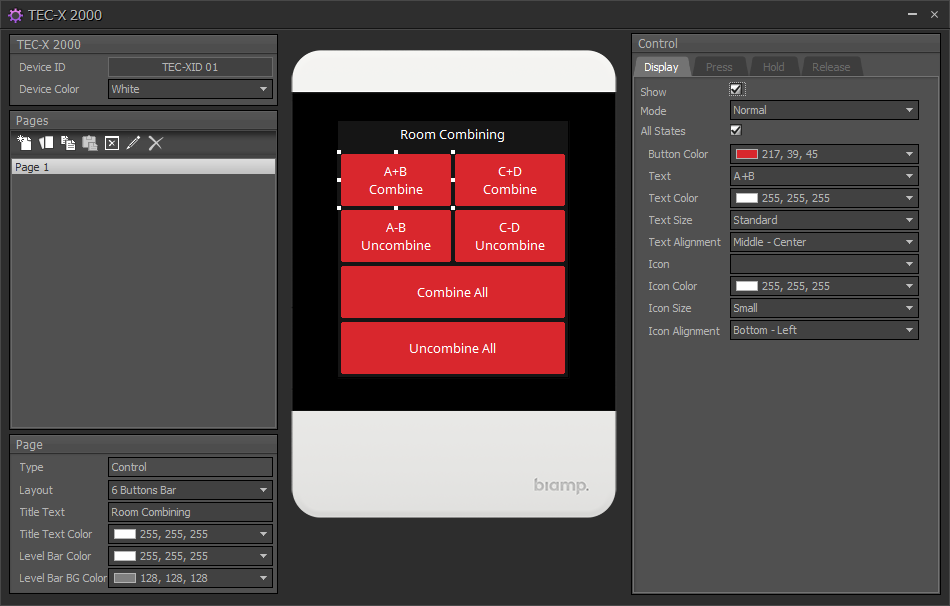
Canvas Software: An optional multi-page Biamp Canvas configuration layout has been provided for this application to be used as an additional point of control for the system integrator or operator. This is an optional part of the system, and is not required for the operation of the file. This Canvas layout is setup with basic controls for the system to allow for level adjustment, source selection, routing, room combining, and muting. It is created as a starting point and may be modified as needed to fit exact needs of the design application. The Canvas help file can be found here for reference.
Control System Integration: The example Tesira configuration file for this application file has been setup to allow third-party control systems to easily control the Tesira system if desired. There are control points for Level, Mute, Room Combining, and Source Selection already in place to allow for you to use as it as-is, or add to as needed to suit the needs of the design. Control points within the file have been left at the default instance ID tag. These tags can be changed as needed to suit the programmer workflow or standardization.
Fire Alarm mute logic
In this application, we have added logic to control muting of the system on a contact closure from the fire alarm or other system. This logic is an optional feature of the file, and may be removed if not needed.
When connecting this fire alarm wiring to a Tesira system, it is important to know whether the switch is normally-open or normally-closed.
On a Tesira logic input, a short circuit will create a low logic signal (i.e., off), and an open circuit will create a high logic signal (i.e., on). Therefore, normally-closed mute switches create normally-low logic signals, and normally-open mute switches create normally-high logic signals.
Tesira logic blocks usually work best with normally-low logic signals. So, if you are working with normally-open switches, you'll usually need to either put the logic signal through a NOT gate, or just enable the Invert button in the Logic Input block.
In the shown configuration, the fire alarm mute will only mute the room and pre-function audio to allow audio from the fire alarm or evac system to be heard. The shown configuration does not have a path for an announcement from those systems to be played over the speakers. This functionality that may be added if needed with modifications to the file.
Further reading
- Tesira Network Infrastructure
- Configuring Attero Tech Dante wall plates
- Dante
- Gain Structure
- Loudspeaker Equalization
- General Audio Concepts
- TEC-X-2000 Landing Page
- TEC-X-1000 Landing Page
- Programming a TEC-X Control Pad to control a Tesira system
- Controlling a Source Selector with a TEC-X Control Pad
- Creating Multi-Page Biamp Canvas Files
- Community D8 ceiling speaker


